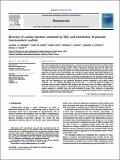| dc.contributor.author | Holladay, Carolyn A. | |
| dc.contributor.author | Duffy, Aoife M. | |
| dc.contributor.author | Chen, Xizhe | |
| dc.contributor.author | O'Brien, Timothy | |
| dc.contributor.author | Pandit, Abhay | |
| dc.date.accessioned | 2012-10-24T09:35:45Z | |
| dc.date.available | 2012-10-24T09:35:45Z | |
| dc.date.issued | 2011-11 | |
| dc.identifier.citation | Holladay, CA,Duffy, AM,Chen, XZ,Sefton, MV,O'Brien, TD,Pandit, AS (2012) 'Recovery of cardiac function mediated by MSC and interleukin-10 plasmid functionalised scaffold'. Biomaterials, 33 :1303-1314. | en_US |
| dc.identifier.issn | 0142-9612 | |
| dc.identifier.uri | http://hdl.handle.net/10379/3003 | |
| dc.description | Journal article | en_US |
| dc.description.abstract | Stem cell transplantation has been suggested as a treatment for myocardial infarction, but clinical studies have yet to demonstrate conclusive, positive effects. This may be related to poor survival of the transplanted stem cells due to the inflammatory response following myocardial infarction. To address this, a scaffold-based stem cell delivery system was functionalised with anti-inflammatory plasmids (interleukin-10) to improve stem cell retention and recovery of cardiac function. Myocardial infarction was induced and these functionalised scaffolds were applied over the infarcted myocardium. Four weeks later, stem cell retention, cardiac function, remodelling and inflammation were quantified. Interleukin-10 gene transfer improved stem cell retention by more than five-fold and the hearts treated with scaffold, stem cells and interleukin-10 had significant functional recovery compared to the scaffold control (scaffold: -10+/-7%, scaffold, interleukin-10 and stem cells: +7 +/-6%). This improved function was associated with increased infarcted wall thickness and increased ratios of collagen type III/type I, decreased cell death, and a change in macrophage markers from mainly cytotoxic in the scaffold group to mainly regulatory in scaffold, stem cells and interleukin-10 group. Thus, treatment of myocardial infarction with stem cells and interleukin-10 gene transfer significantly improved stem cell retention and ultimately improved overall cardiac function. (C) 2011 Elsevier Ltd. All rights reserved. | en_US |
| dc.language.iso | en | en_US |
| dc.relation.ispartof | Biomaterials | en |
| dc.rights | Attribution-NonCommercial-NoDerivs 3.0 Ireland | |
| dc.rights.uri | https://creativecommons.org/licenses/by-nc-nd/3.0/ie/ | |
| dc.subject | Anti-inflammatory gene transfer | en_US |
| dc.subject | Mesenchymal stem cells | en_US |
| dc.subject | Cardiac tissue engineering | en_US |
| dc.subject | Scaffold | en_US |
| dc.subject | Interleukin-10 | en_US |
| dc.title | Recovery of cardiac function mediated by MSC and interleukin-10 plasmid functionalised scaffold | en_US |
| dc.type | Article | en_US |
| dc.date.updated | 2012-10-18T16:23:01Z | |
| dc.identifier.doi | DOI 10.1016/j.biomaterials.2011.10.019 | |
| dc.local.publishedsource | http://dx.doi.org/10.1016/j.biomaterials.2011.10.019 | en_US |
| dc.description.peer-reviewed | peer-reviewed | |
| dc.contributor.funder | |~| | |
| dc.internal.rssid | 2196638 | |
| dc.local.contact | Abhay Shashikant Pandit, Mechanical & Biomedical Eng, College Of Eng & Informatics, Room 304, Nfb Building, Ida Bus Park, Dangan, Nui Galway. 2758 Email: abhay.pandit@oegaillimh.ie | |
| dc.local.copyrightchecked | No | |
| dc.local.version | PUBLISHED | |
| nui.item.downloads | 909 | |


